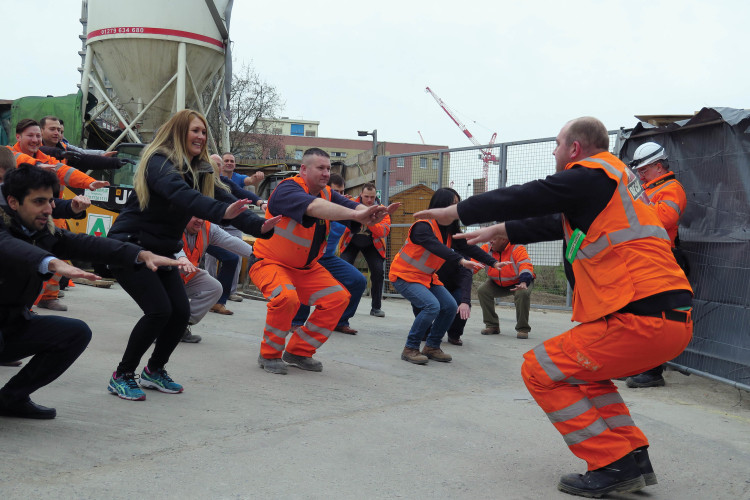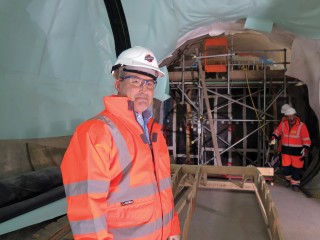It’s 7:30am and the Vauxhall Underground upgrade team are above ground in a tightly fenced-off compound area.
You might expect to see them casually standing around for the usual briefing meeting, but what’s this? They’re in neat lines. On command, the whole group moves as one, attempting side bends, rotating hips and touching toes.
They’re stretching and flexing in unison, waving their arms and lengthening out their calf muscles and hamstrings. There’s some puffing, fierce concentration and a bit of good-natured banter. Designers, tunnellers, excavator operators and administrative staff are all mixed in together. Even senior managers and client London Underground are taking part.
Early morning exercises for workers are, of course, de rigeur in some countries – notably Japan. But this is a sight so unusual in the UK that someone – a commuter or tourist – has stopped to film the action from the other side of the road.
The daily event was introduced by Bechtel field engineer Lani Tan. Having worked on various projects abroad where Bechtel was the main contractor, Tan was well-versed in the morning flex-and-stretch exercise routine, and was keen to share it with her colleagues when she returned home.
“It’s been very good for team building,” she explains. “There has been no shortage of volunteers to lead each session. It’s also helped build confidence with some of the quieter members. They feel more comfortable speaking up in meetings now.” The early morning ritual may become a more frequent sight as Bechtel takes on more contractor-based work in the UK. For the past two decades, Bechtel’s role in UK-based construction projects has mainly been as programme manager, best known for running major infrastructure projects such as Crossrail and the West Coast Mainline. But the £36m Vauxhall upgrade, although small, is a milestone for the company, marking a return to contracting work.
“This project has got a different feel to it for us,” admits Bechtel project manager Matt Lagar. “It’s been a learning curve. As this is our first job as a contractor in this country for some time, we’ve been building up our relationships with the supply chain.”
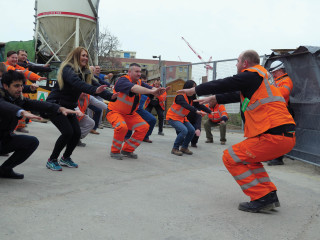
The project is also a milestone for the client: it’s the first London Underground project where the use of BIM level 2 has been written into the contract (see box p21). The Vauxhall project is a necessary and urgent undertaking. Vauxhall is at the eastern extremity of Nine Elms, one of the biggest regeneration schemes in Europe with 21,000 new homes and more than 600,000m2 of commercial space under development. Prestigious new neighbours such as the US Embassy are due to move into the area in 2017.
The new Northern Line Extension from Kennington to Battersea Power Station will provide essential transport to and from the new development. But this will only cater for some of the major influx of daily traffic. The existing Vauxhall Tube station, at the other end of the development, will also be crucial. Around 21 million people already pass through Vauxhall Underground station annually, and passenger figures are expected to rise by 40% within a few years. The project is a job of two halves: the first, desperately needed by local commuters, is to relieve congestion within the ticket hall area.
Offices and shops have been swept away in order to widen the hall by 4.5m and add four new ticket barriers.
In the new streamlined configuration, all 12 barriers will be aligned, enabling station staff to alter the direction in which they open, in order to manage passenger flow better.
There is also some standard station modernisation work: new tiling, lighting and improved CCTV coverage in the five subways. But a hefty part of the project is a new 16-person lift, providing step-free access between the ticket hall and platform. The construction of the lift-shaft is almost a separate project in itself, and some innovative thinking has enabled project costs to be slashed from £45m to £36m. Normally this kind of excavation would be started from street level, but this would have been hugely disruptive at Vauxhall, a busy transport hub. A bus station sits above the underground on an island surrounded by a major traffic gyratory system.
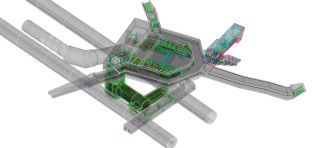
“Because of the location, there would have been a huge amount of disruption to the traffic, and we would have had to do enormous amounts of enabling works to move all the utilities,” Lagar explains.
Instead, a robotic Brokk mini excavator was brought down the passenger subways and tunnelling contractor JG Gallagher started excavating behind hoardings at ticket hall level. Six steel beams, up to 1m in depth, have been installed to support the roof above the shaft. “The beams are helping to hold up the road above,” Tan says.
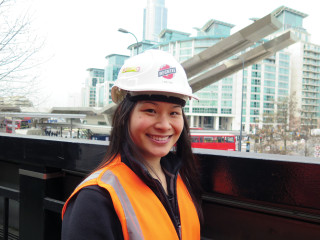
A major challenge has been the restrictions on the way the team must operate. The only means of delivering equipment and materials to - and removing spoil from - the excavation, has been a 3-tonne gantry crane above the shaft opening with a “coffin skip” attached. Headroom is a challenge almost everywhere. “The height between the top of the shaft and the underside of the crane is 1.4m,” Lagar emphasises.

The excavation plan is clever, but with a high water table, and the Thames only about 30m from the site, this was never going to be a straightforward job. Conditions were even more challenging than expected. The contractor found three metres of gravel lying directly beneath the 3m-deep layer of concrete slab and made ground which supports the original station structure. “We knew that the London gravel would be heavy with water,” says Lagar, “we just didn’t anticipate the volume.”
The problem was dealt with by increased dewatering, carrying out additional grout injection, and using pocket excavation techniques where smaller sections are removed at a time.
The original plan for excavating the 9.8mdiameter shaft had been to divide it into thirds and spray the 250mm concrete lining for each 1m-deep segment before moving to the other two. The dramatic ingress of water called for a rethink. “At the gravel layers, we had to take very small bites, dividing the shaft into twelfths, and spraying each segment as we did it,” Lagar says.
“Even when we got down to the good clay, the excavation still had to be divided into thirds.” After three months, the shaft was excavated to a depth of 17m below ticket hall level and work began on constructing the 18m connecting tunnel and cross passages to the platforms.
Underground, conditions are extremely cramped. The diameter of the cross passages is 5.9m at its widest. As a tunnelling project, this is light years away from Crossrail, which has had the luxury of tunnel boring machines and precast concrete segments. In these cramped conditions formwork was assembled by hand, and concrete pumped in situ over the sprayed concrete lining layer. The Brokk used to excavate the shaft was eventually joined by an additional diesel-driven Bobcat mini excavator. “We had to partly dismantle the Bobcat to lower it into the shaft, and reassemble it below,” Tans says.
“Using two excavators definitely helped us improve our productivity,” Lagar adds. “One was excavating, whilst the other was moving the muck.”
He adds that the project is on schedule for completion in spring 2016, and the new lift will be installed by the end of this year. Tan expects to stay with the project until completion, joking that she hopes to be the person that finally turns out the lights. She adds that Vauxhall has been a great experience, particularly as 35% of Bechtel and London Underground engineers on this project are women. This is an impressive figure for such a male-dominated sector. “I hope this statistic will be less surprising in the future. This project feels very inclusive. It feels much more balanced,” says Tan.
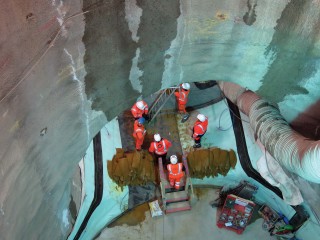
Working with BIM
The Vauxhall Underground upgrade is the first London Underground project in which building information modelling (BIM) level 2 has been written into the contract.
“This has been a good step for London Underground, as all government projects will be required to use BIM level 2 from 2016 onwards,” says Lani Tan, who recently added the role of BIM coordinator to her duties as field engineer. “It’s been a really good learning ground, and it has helped us all focus,” she says. Using BIM for a new building on a greenfield site is one thing, but creating a model based on an existing, fully-operational underground station, dating back to the early 1970s, was a greater challenge.
The 3D digital model for Vauxhall was created from the original 2D paper drawings. “Our drawings were stripping back to the structural elements, but as the station still needed to be fully functioning, we weren’t able to use tools such as laser scanners,” Tan says.
“But whenever we have worked in a specific area, we have carried out checks on where the structural elements were, and checked them back against the original model, to see whether there had been any changes.”
An additional task has been converting imperial measurements of feet and inches, but Tan says that the original drawings have largely been accurate, and only small revisions have been necessary.
In the early days of the project, the digital model was largely used as a design collaboration tool, shared between the disciplines. Now that Vauxhall is in the construction phase, the fourth dimension – time – has become more prominent.
“Our planning team are now tying the 4D BIM model to the programme,” Tan says. This represents a big shift in how BIM is being perceived. “BIM is not seen merely as an engineering tool any more. Other departments and disciplines are using it in new ways,” she says.
This article first appeared in the July 2015 issue of The Construction Index magazine. To read the full magazine online, click here.
To receive you own hard copy each month in traditional paper format, you can subscribe at
http://www.theconstructionindex.co.uk/magazine#
Got a story? Email news@theconstructionindex.co.uk

